On the map above:
blue: places to visit that are not section 482
purple: section 482 properties
red: accommodation
yellow: less expensive accommodation for two
orange: “whole house rental” i.e. those properties that are only for large group accommodations or weddings, e.g. 10 or more people.
green: gardens to visit
grey: ruins
Carlow, Dublin, Kildare, Kilkenny, Laois, Longford, Louth, Meath, Offaly, Westmeath, Wexford and Wicklow are the counties that make up the Leinster region.
As well as places to visit, I have listed separately places to stay, because some of them are worth visiting – you may be able to visit for afternoon tea or a meal.
For places to stay, I have made a rough estimate of prices at time of publication:
€ = up to approximately €150 per night for two people sharing (in yellow on map);
€€ – up to approx €250 per night for two;
€€€ – over €250 per night for two.
For a full listing of accommodation in big houses in Ireland, see my accommodation page: https://irishhistorichouses.com/accommodation/
Places to visit in County Westmeath:
1. Athlone Castle, County Westmeath
2. Belvedere House, Gardens and Park, County Westmeath
3. Killua Castle, County Westmeath https://killuacastle.com/guided-tours/
4. Lough Park House, Castlepollard, Co. Westmeath
5. Rockfield Ecological Estate, Rathaspic, Rathowen, Mullingar, Co. Westmeath
6. St. John’s Church, Loughstown, Drumcree, Collinstown, Co. Westmeath
7. Tullynally Castle & Gardens, Castlepollard, Co. Westmeath
8. Turbotstown, Coole, Co. Westmeath
9. Tyrrelspass Castle, County Westmeath – restaurant and gift shop
Places to stay, County Westmeath:
1. Annebrook House Hotel, Austin Friars Street, Mullingar, Co. Westmeath, N91YH2F €
2. Lough Bawn House, Colllinstown, County Westmeath €€
3. Lough Bishop House, Collinstown, County Westmeath €
4. Mornington House, County Westmeath €€
Whole House Rental/wedding venue, County Westmeath:
1. Bishopstown House, Rosemount, County Westmeath – whole house rental (sleeps up to 18 people)
2. Middleton Park, Mullingar, County Westmeath – whole house rental and weddings

donation
Help me to pay the entrance fee to one of the houses on this website. This site is created purely out of love for the subject and I receive no payment so any donation is appreciated!
€10.00
Places to visit in County Westmeath:
1. Athlone Castle, County Westmeath

The website tells us: “Trace the footprints of the generations who shaped this place. From early settlements and warring chieftains to foreign invaders and local heroes. This site on the River Shannon is the centre of Ireland’s Hidden Heartlands.
“Over the centuries it has been the nucleus of the Anglo-Norman settlement; a stronghold of the rival local families the Dillons and the O’Kelly’s; the seat of the Court of Claims; the residence of the President of Connaught and the Jacobite stronghold during the sieges of Athlone. After the Siege of Athlone it became incorporated into the new military barrack complex. It remained a stronghold of the garrison for almost three hundred years.
“In 1922 when the Free State troops took over the Barracks from their British counterparts, they proudly flew the tricolour from a temporary flagpole much to the delight of the majority of townspeople.
“In 1967 the Old Athlone Society established a museum in the castle with a range of exhibits relating to Athlone and its environs and also to folk-life in the district. Two years later when the military left the castle it was handed over to the Office of Public Works and the central keep became a National Monument.
“In 1991 to mark the Tercentenary of the Siege of Athlone the castle became the foremost visitor attraction in Athlone. Athlone Town Council (then Athlone UDC) made a major investment in the castle creating a multi-faceted Visitor Centre as it approached its 800th Anniversary in 2010. A total of €4.3million euro was invested in the new facility by Fáilte Ireland and Athlone Town Council and was officially opened by the then Minister of State for Tourism and Sport, Michael Ring T.D. on Tuesday 26th February 2012.“

“Athlone Castle Visitor Centre is now a modern, engaging, fun and unique family attraction which harnesses most significant architectural features, such as the keep, to act as a dramatic backdrop to its diverse and fascinating story.
“It houses eight individual exhibition spaces, each depicting a different aspect of life in Athlone, the Castle and the periods both before and after the famous Siege. Fun, hands-on interactives, touchable objects and educational narratives immerse visitors in the drama, tragedy and spectacle of Athlone’s diverse and fascinating story. 3D maps, audio-visual installations, illustrations and artefacts bring the stories and characters of Athlone to life and The Great Siege of Athlone is dramatically recreated in a 360-degree cinematic experience in the Keep of the castle.“

“As part of Westmeath County Council’s commemoration of Ireland’s world-renowned tenor, John Count McCormack, a new exhibition dedicated to the celebrated singer was opened at Athlone Castle in October 2014.“
Archiseek tells us about Athlone Castle: “Towards the end of the 12th century the Anglo-Normans constructed a motte-and-bailey fortification here. This was superceeded by a stone structure built in 1210, on the orders of King John of England. The Castle was built by John de Gray, Bishop of Norwich. The 12-sided donjon dates from this time. The rest of the castle was largely destroyed during the Siege of Athlone and subsequently rebuilt and enlarged upon. In the early 1800s, during the Napoleonic Wars, the castle was rebuilt as a fortification to protect the river crossing, taking the form we largely see today. The machicolations of the central keep are all nineteenth century. In the interior is an early nineteenth century two-storey barrack building. The modern ramp up to the castle has a line of pistol loops. The castle was taken over by the Irish Army in 1922 and continued as a military installation until it was transferred to the Office of Public Works in 1970.” [8]

2. Belvedere House, Gardens and Park, County Westmeath
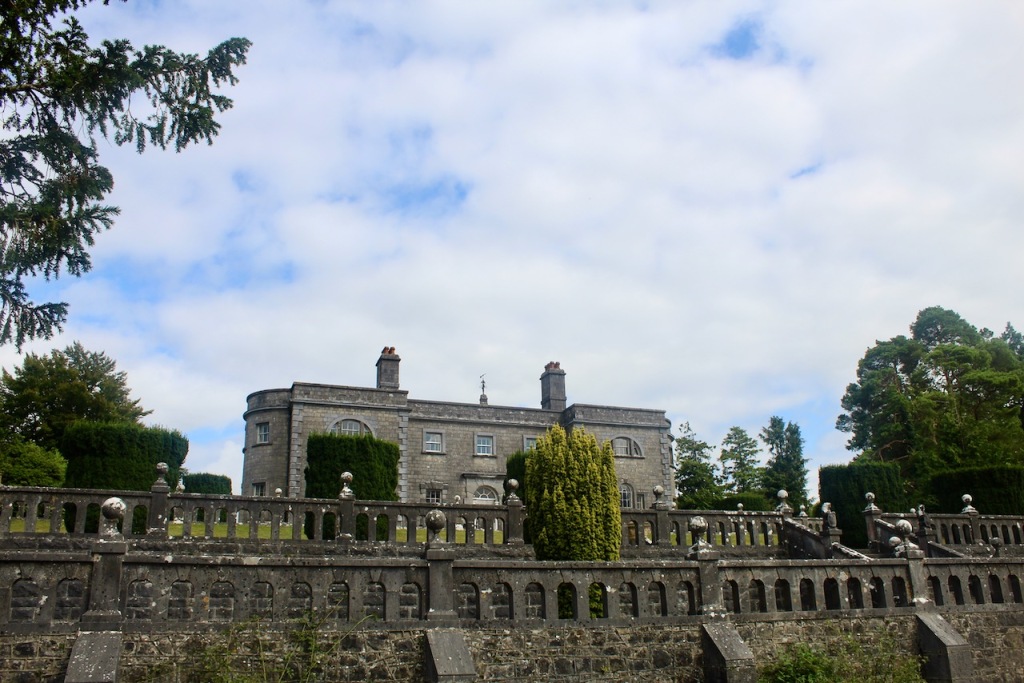
http://www.belvedere-house.ie/
Mark Bence-Jones writes of Belvedere in his 1988 book:
p. 39. “(Rochfort, sub Belvedere, E/DEP Rochfort/LGI1912; Marlay/LGI1912; Howard-Bury, sub Suffolk and Berkshire, E/PB; and Bury/IFR) An exquisite villa of ca 1740 by Richard Castle, on the shores of Lough Ennell; built for Robert Rochfort, Lord Bellfield, afterwards 1st Earl of Belvedere, whose seat was at Gaulston, ca 5 miles away. Of two storeys over basement, with a long front and curved end bows – it may well be the earliest bow-ended house in Ireland – but little more than one room deep.”


Bence-Jones continues: “The front has a three bay recessed centre between projecting end bays, each of which originally had a Venetian window below a Diocletian window. Rusticated doorcase and rusticated window surrounds on either side of it; high roof parapet. The house contains only a few rooms, but they are of fine proportions and those on the ground floor have rococo plasterwork ceilings of the greatest delicacy and gaiety, with cherubs and other figures emerging from clouds, by the same artist as the ceilings formerly are Mespil House, Dublin, one of which is now in Aras.” When Robert Rochfort decided to use Belvedere as his principal residence he employed Barthelemij Cramillion, the French Stuccadore, to execute the principal ceilings. The Rococo plasterwork ceilings were completed circa 1760.
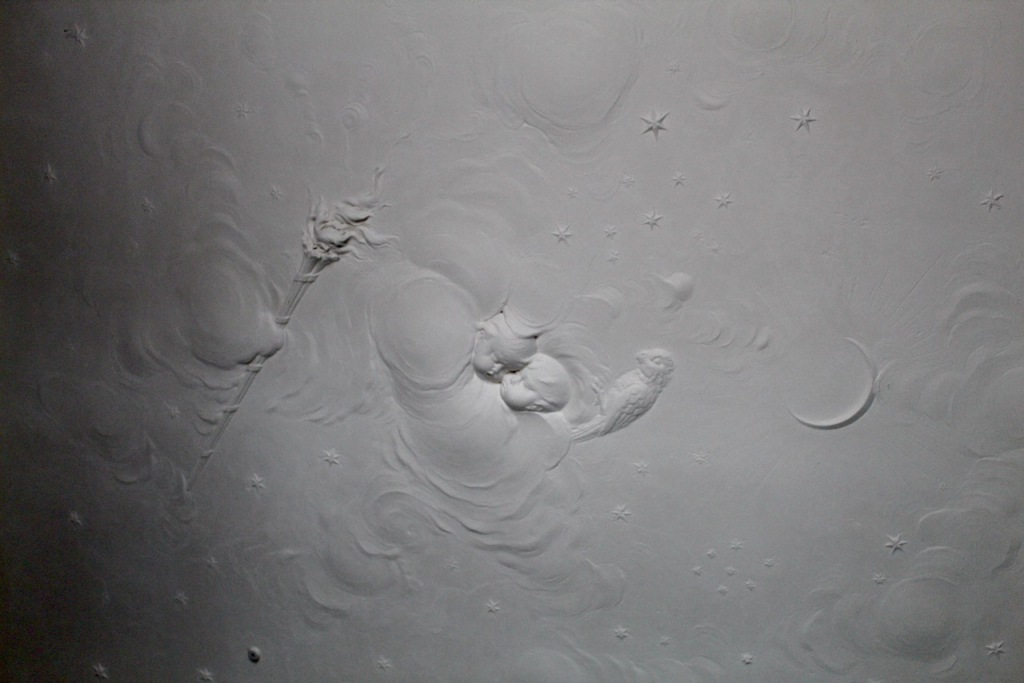
Bence-Jones tells of the house’s occupants; “Soon after the house was finished, Lord Bellfield’s beautiful wife [Mary Molesworth, daughter of Richard, 3rd Viscount Molesworth of Swords, Dublin] confessed to him that she had committed adultery with his brother; whereupon he incarcerated her at Gaulston, where she remained, forbidden to see anyone but servants, until his death nearly thirty years later; while he lived a bachelor’s life of great elegance and luxury at Belvedere. Another of his brothers lived close to Belvedere at Rochfort (afterwards Tudenham Park); having quarrelled with him too, Lord Belvedere, as he had now become, built the largest Gothic sham ruin in Ireland to blot out the view of his brother’s house; it is popularly known as the Jealous Wall. In C19, the Diocletian windows in the front of the house were replaced with rectangular triple windows; and the slope from the front of the house down to the lough was elaborately terraced. Belvedere passed by inheritance to the Marlay family and then to late Lt-Col C.K. Howard-Bury, leader of the 1921 Mount Everest Expedition; who bequeathed it to Mr Rex Beaumont.” (see [3])

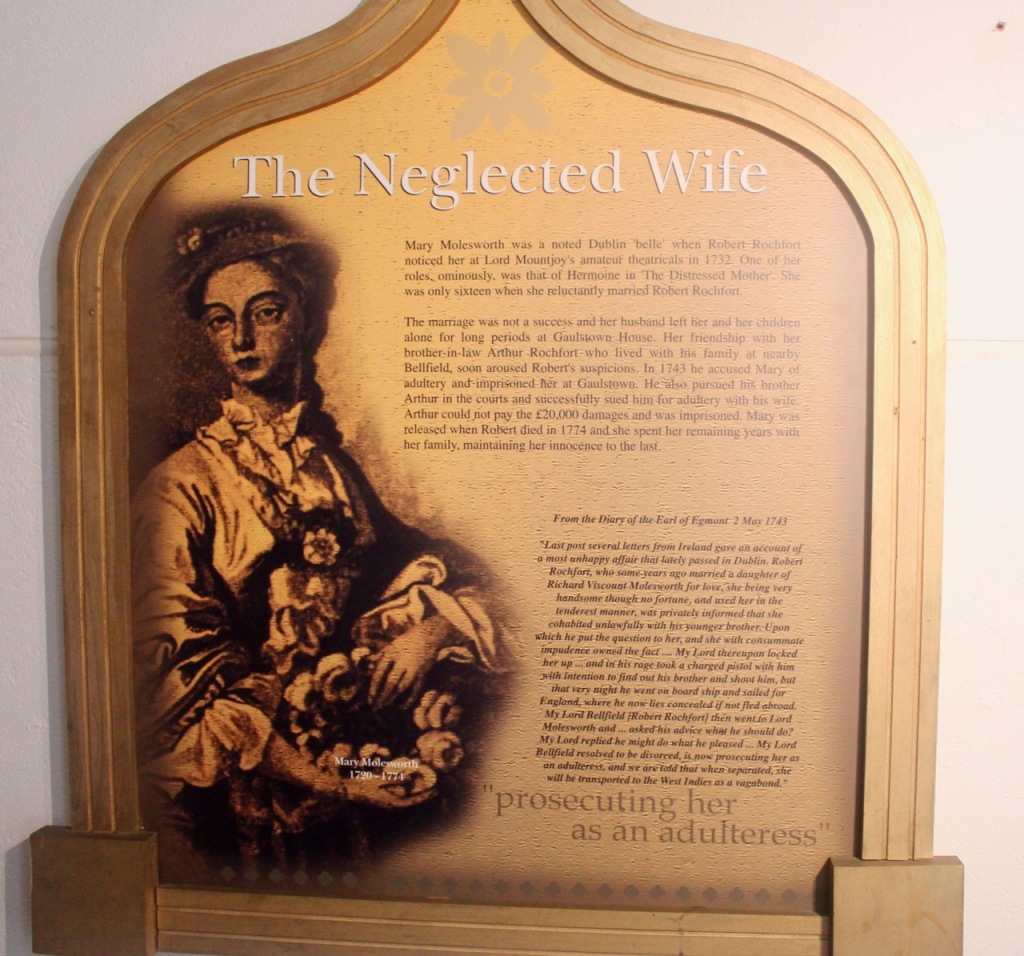
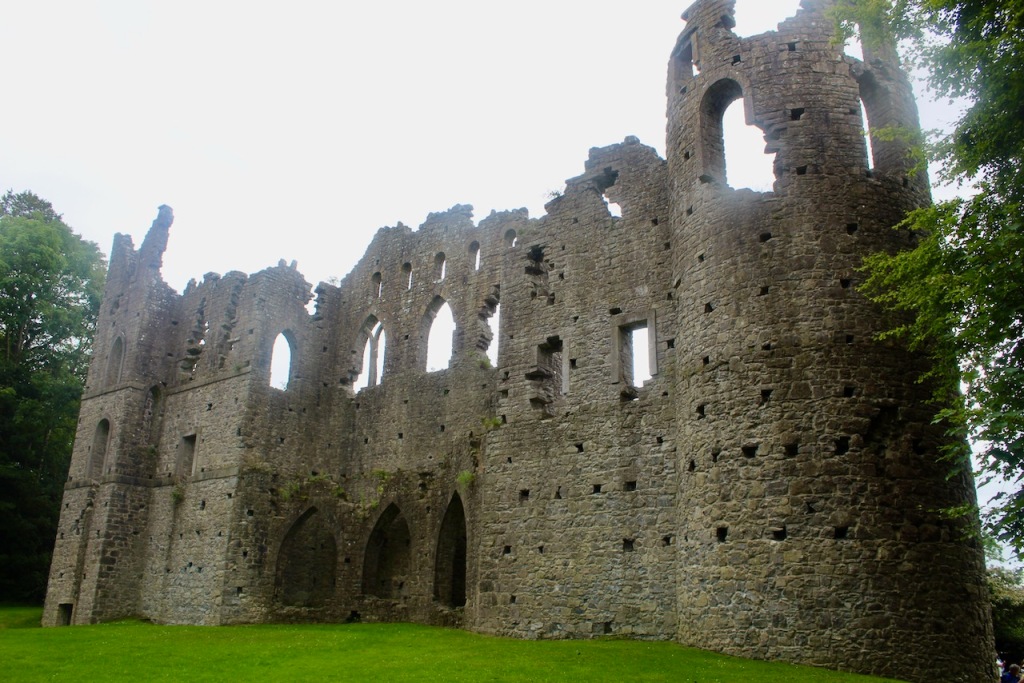
The jealous wall is rather disappointingly attached to the visitor centre of Belvedere at the entrance to the park.

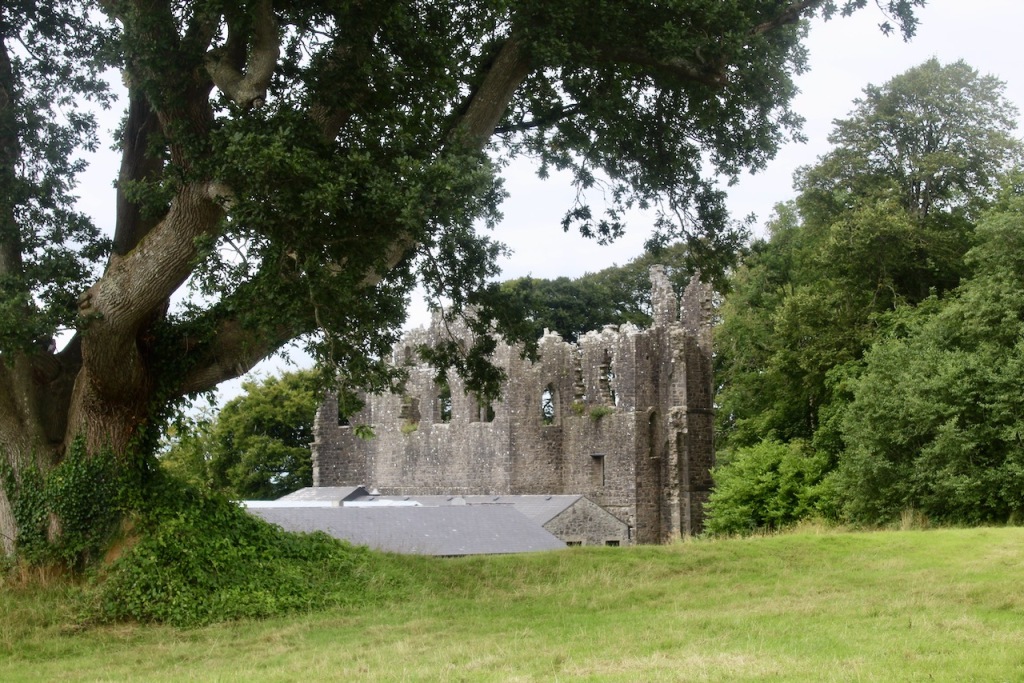
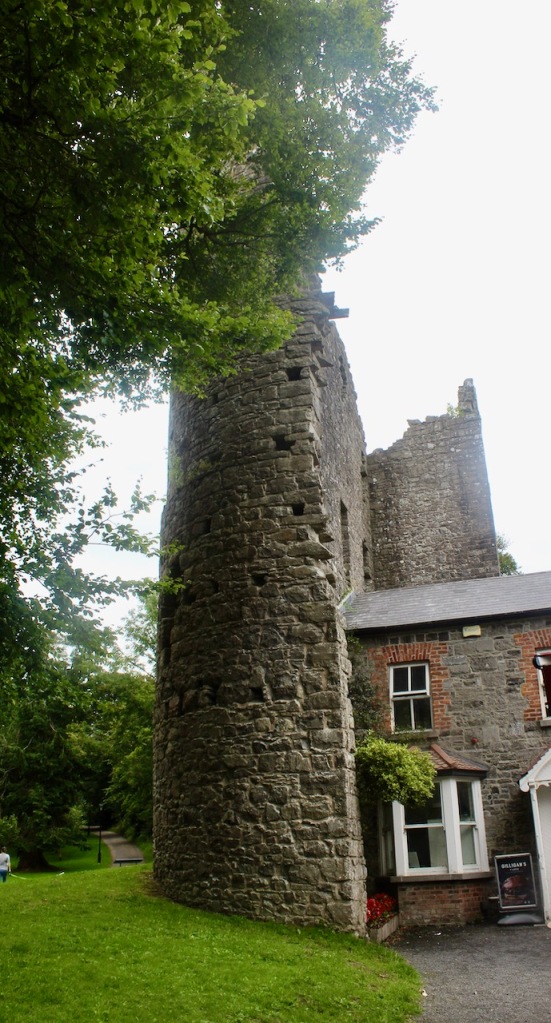


Robert Rochfort managed to have children despite his antipathy toward his wife. George Rochfort (1738-1814), 2nd Earl of Belvedere inherited Belvedere and other estates when his father died in 1774. He also inherited debts, and sold Gaulston House, the house where his mother had been imprisoned by his father. Unfortunately Gaulston House was destroyed by fire in 1920. George Rochfort built an extension onto the rear of Belvedere but spent most of his time in his townhouse, Belvedere House in Great Denmark Street, Dublin.
The 2nd Earl of Belvedere had no children. His wife inherited his Dublin property but his sister Jane inherited Belvedere. Jane married Brinsley Butler, 2nd Earl of Lanesborough. She inherited Belvedere when she was 77 years old! She had married a second time and the income from the estate allowed herself and her second husband to live in fine style in Florence. The male line of the Earls of Lanesborough died out after two more generations. Jane’s son Robert Henry Butler (1759-1806) 3rd Earl of Lanesborough married Elizabeth La Touche, daughter of David La Touche and Elizabeth Marlay, whom we came across when we visited Harristown, County Kildare (see my entry) and Marlay Park in Rathfarnham, Dublin. The estate passed down to their son, Brinsley Butler, 4th Earl of Lanesborough. The estate then passed through the female line. The 3rd Earl’s sister Catherine married George Marlay (1748-1829), the brother of Elizabeth who married David La Touche.
Catherine and George Marlay had a son, George, who married Catherine Tisdall, and the estate passed to his son, Charles Brinsley Marlay (1831-1912). He was only sixteen when he inherited Belvedere from his cousin the Earl of Lanesborough. It was Charles Brisley Marlay who built the terraces leading down to the lake, in the late 1880s. The twelve stone lions were added later. He spent many hours planning the 60 metre long rockery to the side of the terraces, and also built the walled garden. He was known as “the Darling Landlord” due to his kindness to tenants, and for bringing happiness and wealth back to Belvedere. He was cultured and amassed an important art collection, as well as improving the estate.

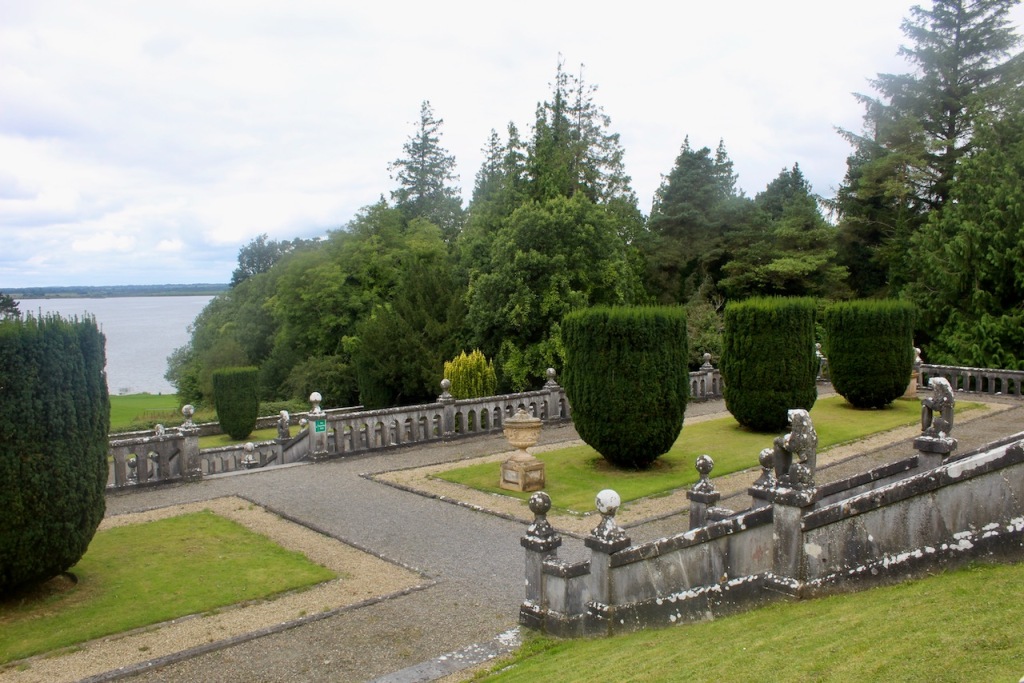
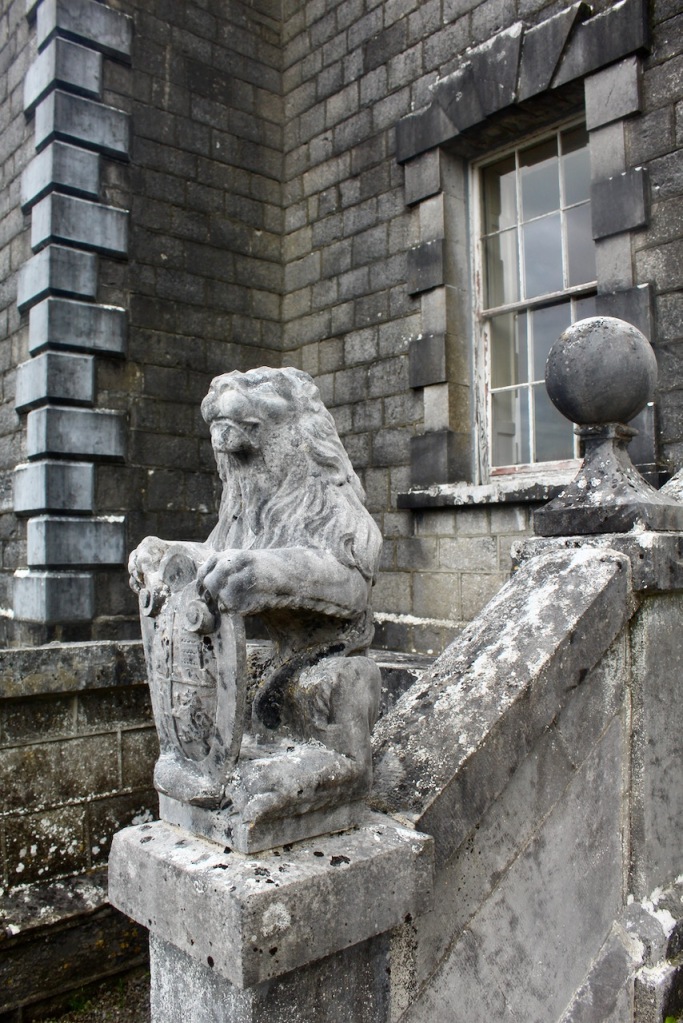

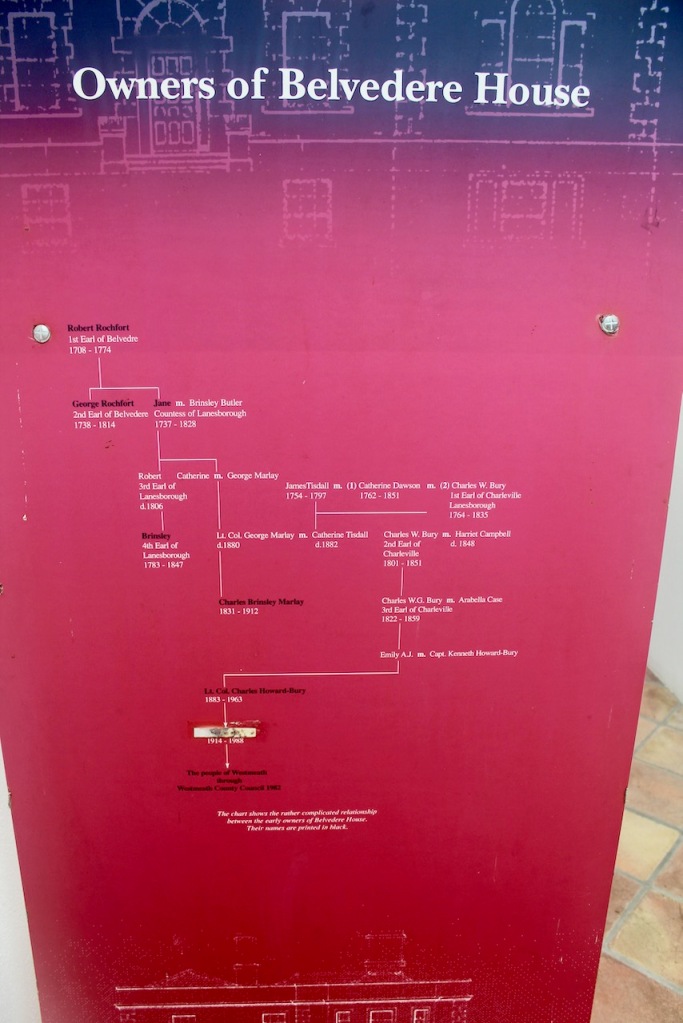
The inheritance of Belvedere continues to be even more complicated. It passed via Catherine Tisdall’s family. Her mother Catherine Dawson had married twice. Catherine’s second husband was Charles William Bury (1764-1835), the 1st Earl of Charleville. We came across him earlier, as an owner of Charleville Forest, in Tullamore, County Offaly. Belvedere passed to his descendent, Lt. Col Charles Howard-Bury (1883-1963). The 3rd Earl of Charleville, Charles William George Bury (1822-1859) had several children but the house passed to the fourth child as all others had died before Charles Brinsley Marley died. It was therefore the son of Emily Alfreda Julia Bury (1856-1931) who inherited Belvedere. She married Kenneth Howard, who added Bury to his surname. Their son was Charles Kenneth Howard-Bury.


Charles Howard-Bury left Belvedere to his friend, Rex Beaumont. Eventally financial difficulties caused Mr Beaumont to sell the property, and it was acquired by Westmeath County Council. Two years previously, in 1980, Mr Beaumont sold the contents of the house – I wonder where those things ended up?
The estate is a wonderful amenity for County Westmeath, with large parklands to explore with several follies, as well as the walled garden.
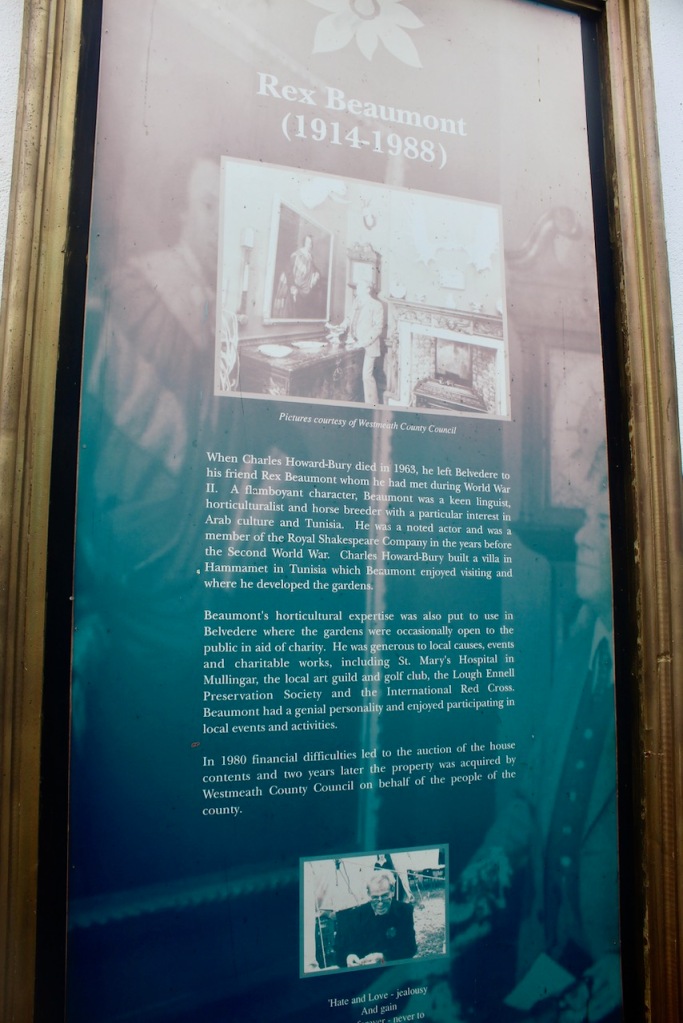
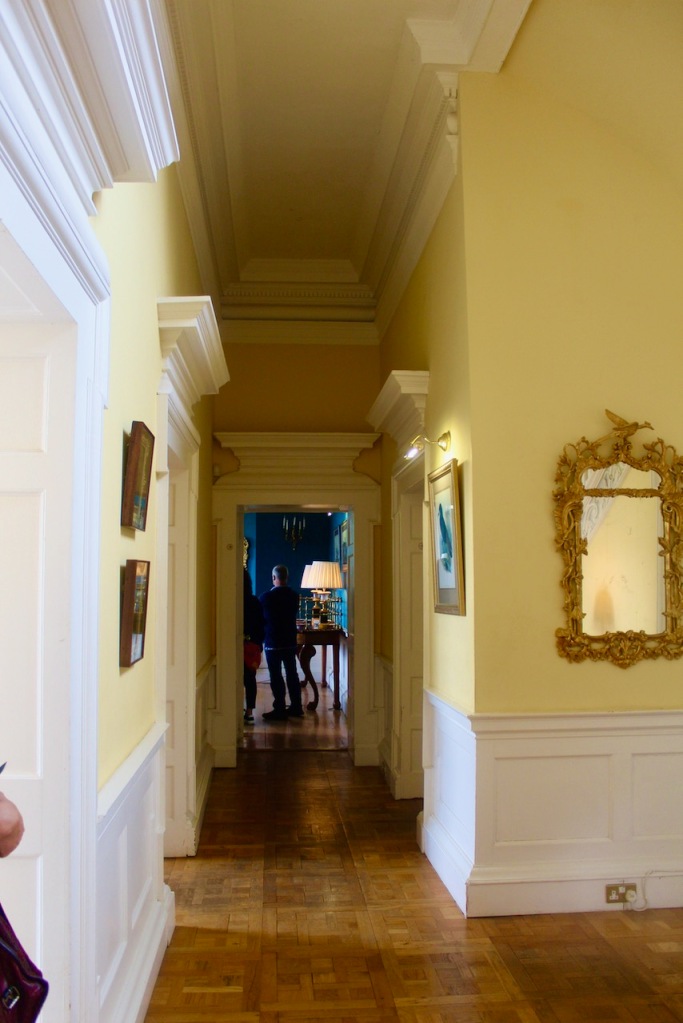

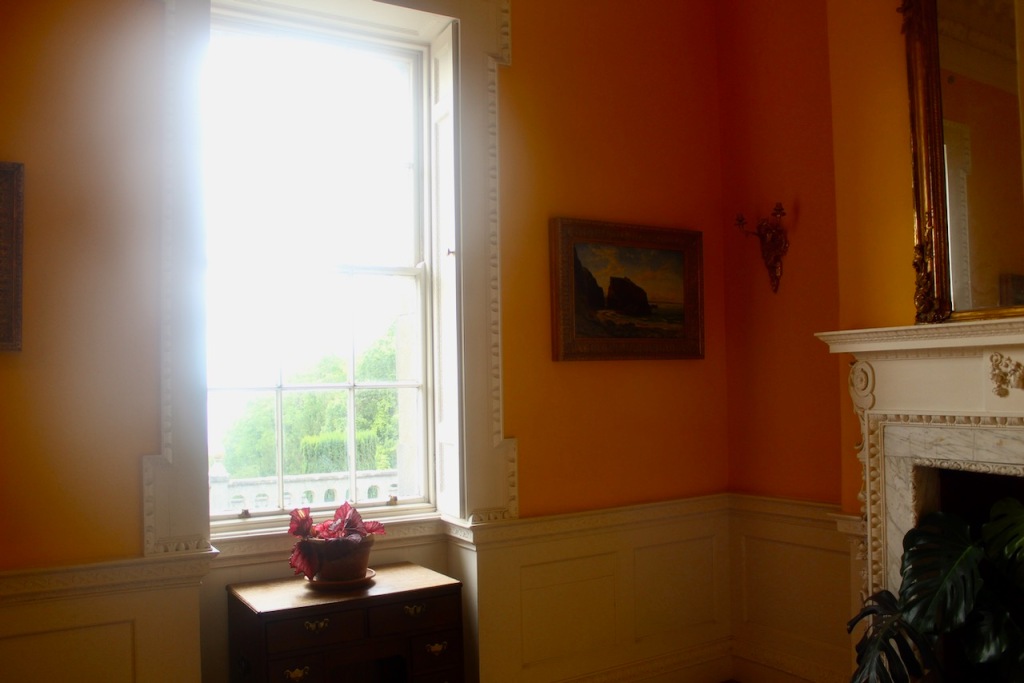


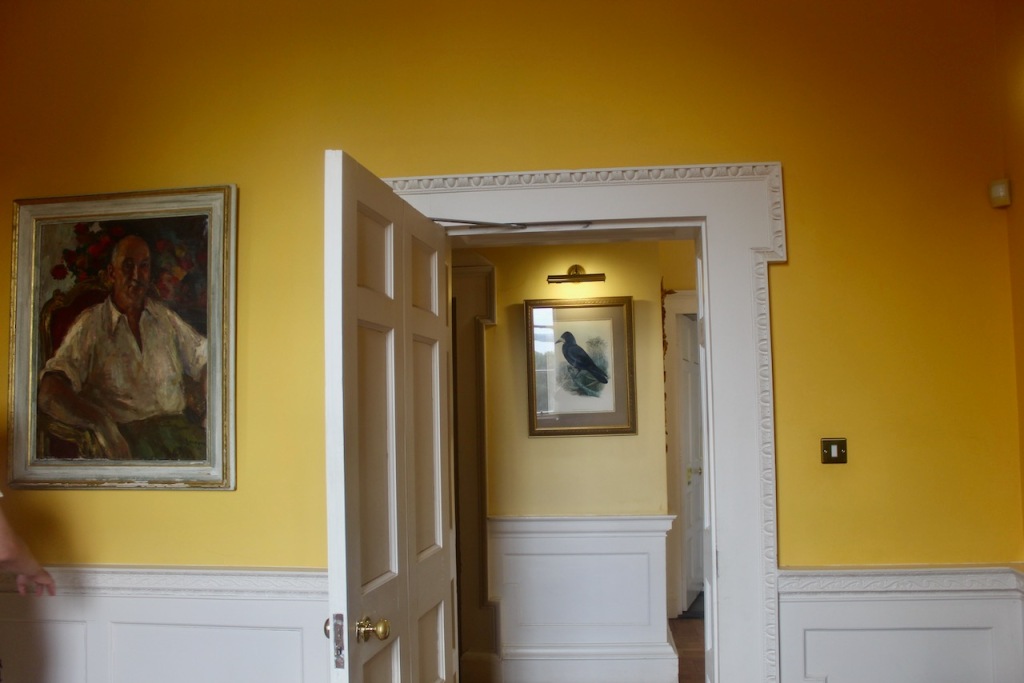

In Belvedere, dining was an opportunity to impress guests not only by the room but by the sumptuous meals, presented by immaculately dressed servants. The rococo ceiling of puffing cherubs and fruits and foliage is attributed to Barthelemji Cramillion, a French stuccodore.

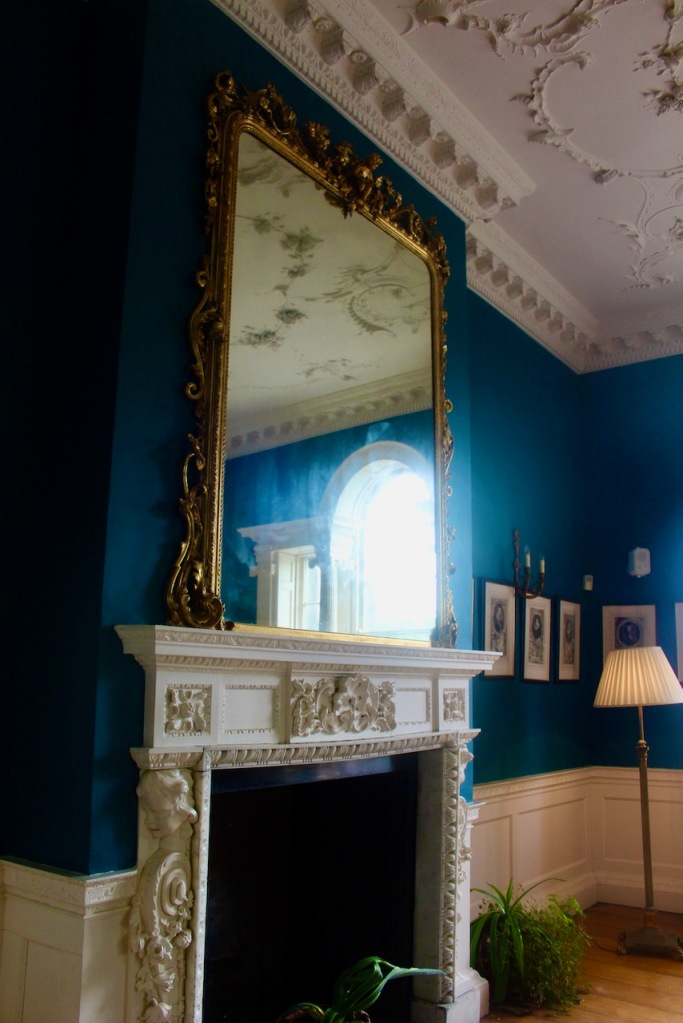
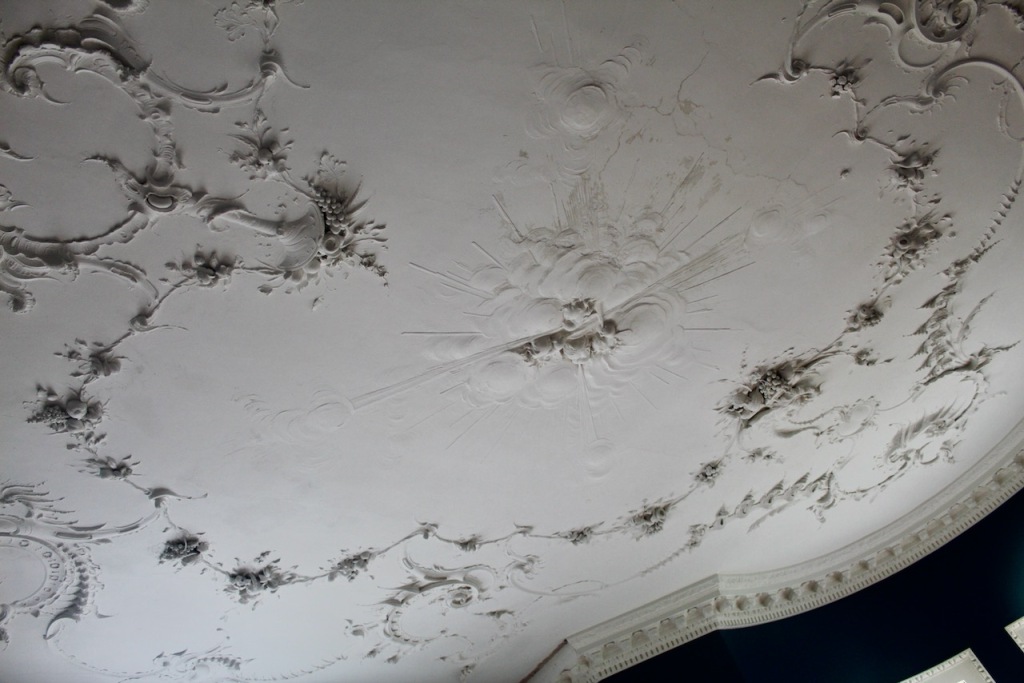

Bence-Jones continues: “The staircase, wood and partly curving, is in proportion to the back of the house.“
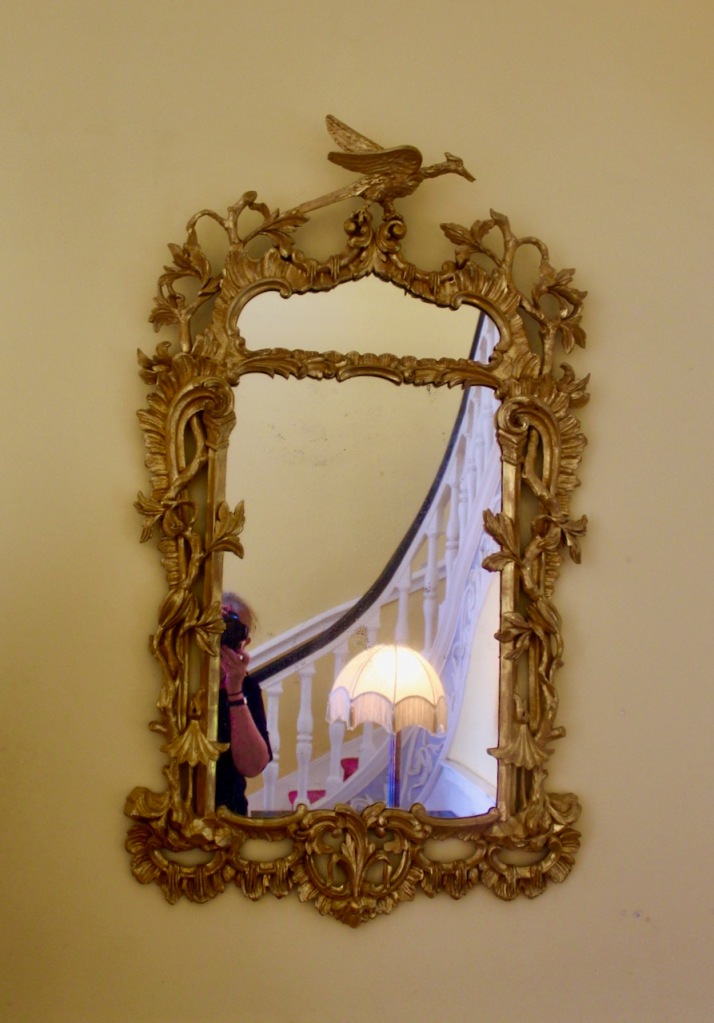
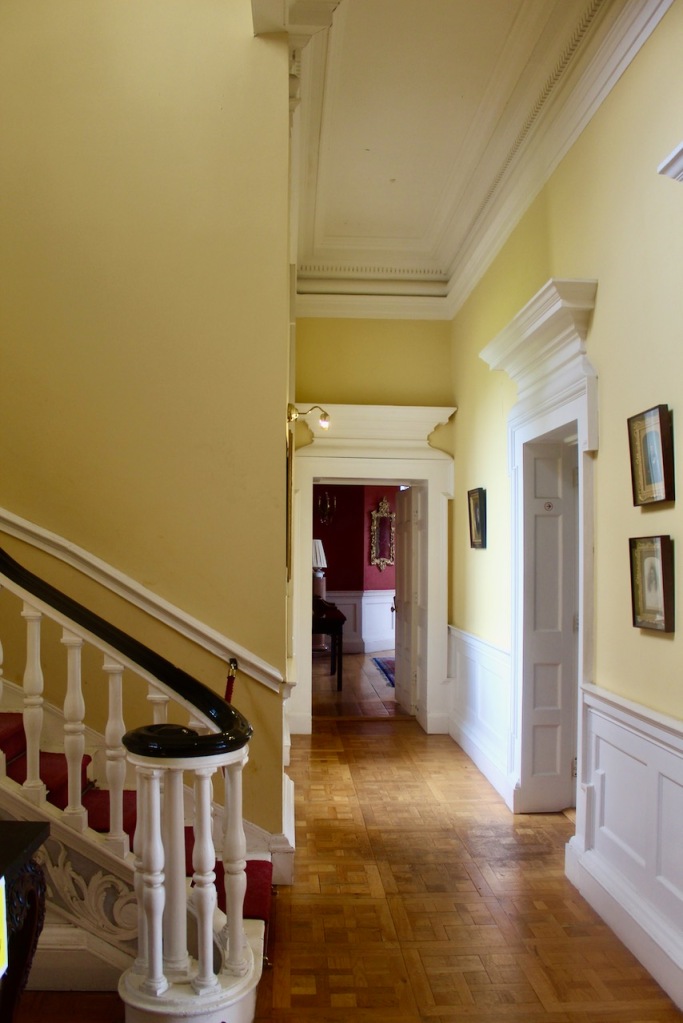
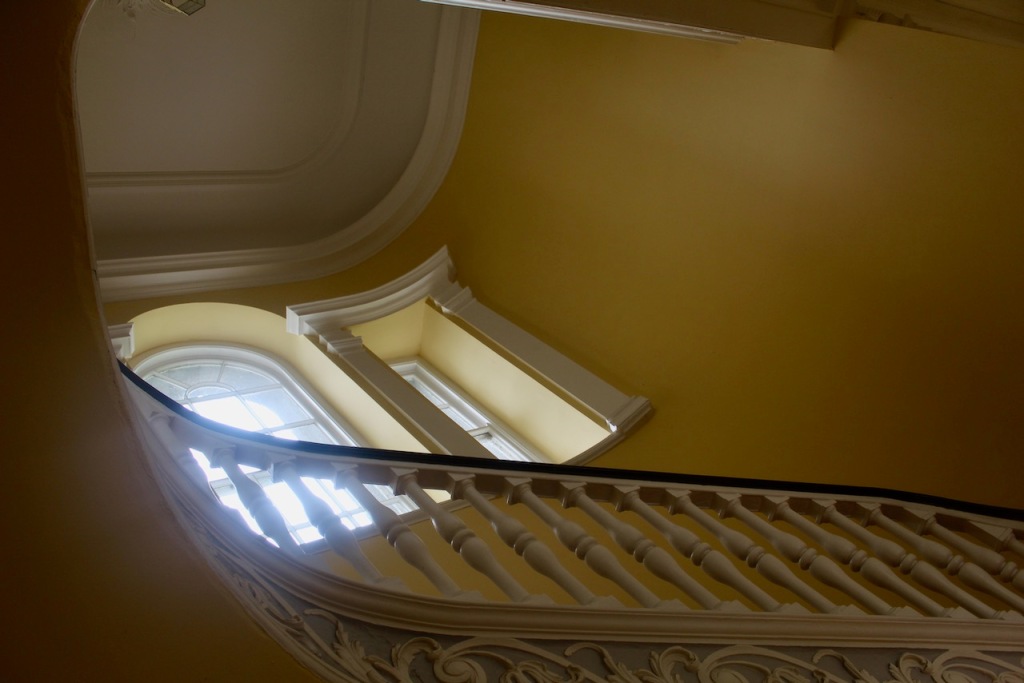
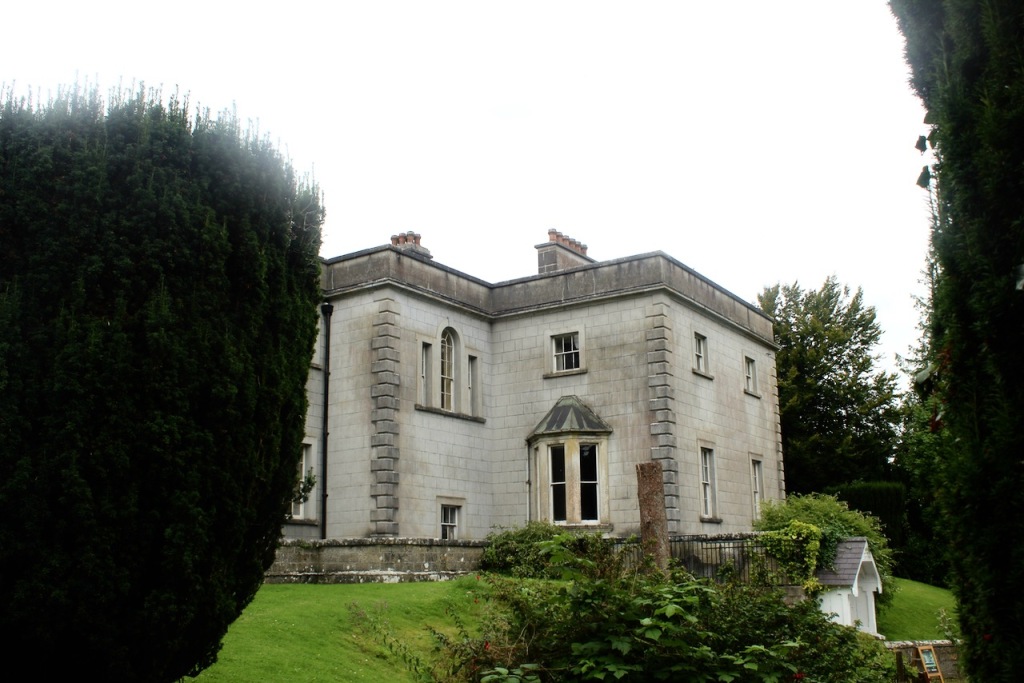



Information boards tells us that the Drawing Room was the place for afternoon tea, after-dinner drinks, music and conversation. Belvedere’s last owners, Charles Howard-Bury and Rex Beaumont would have passed many happy hours relaxing and reminiscing about their wartime experiences and travels across the world, as well as planning trips to Tunisia and Jamaica.
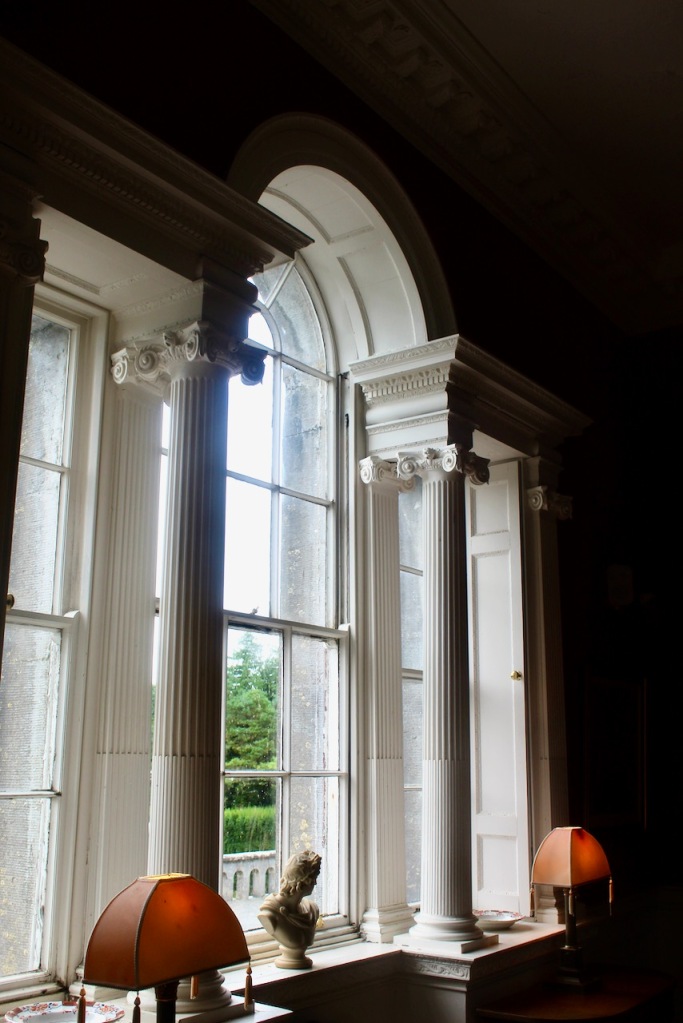


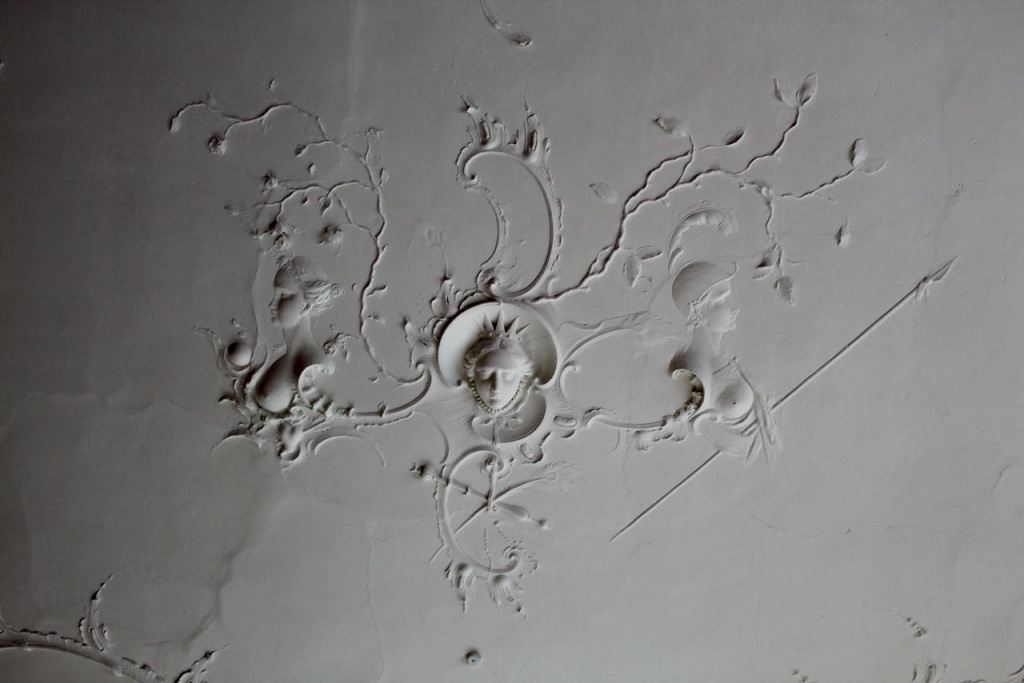


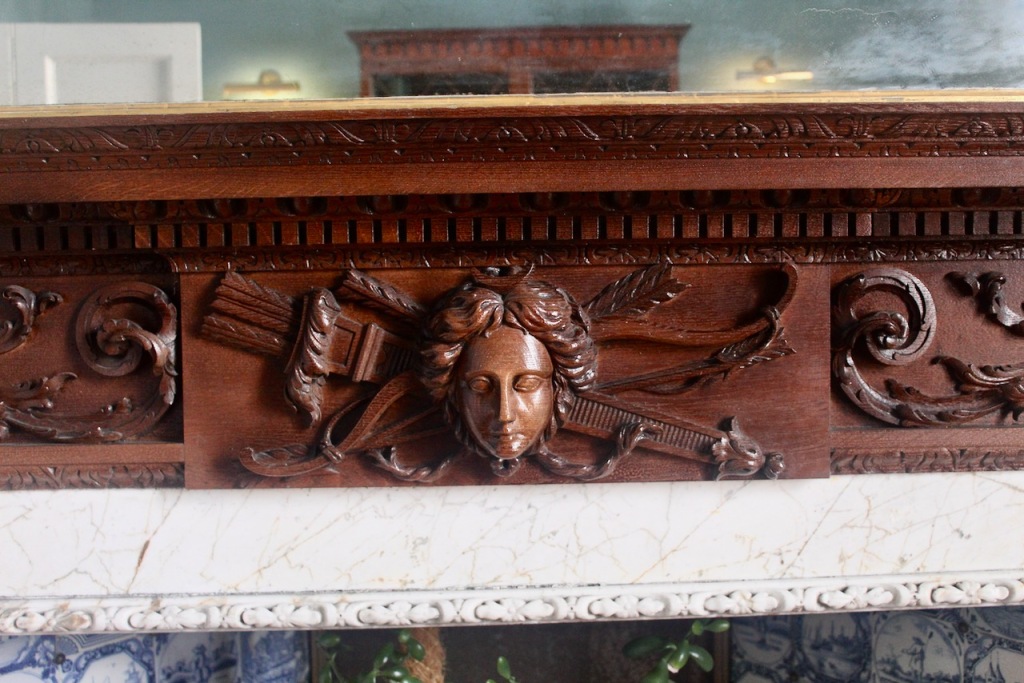


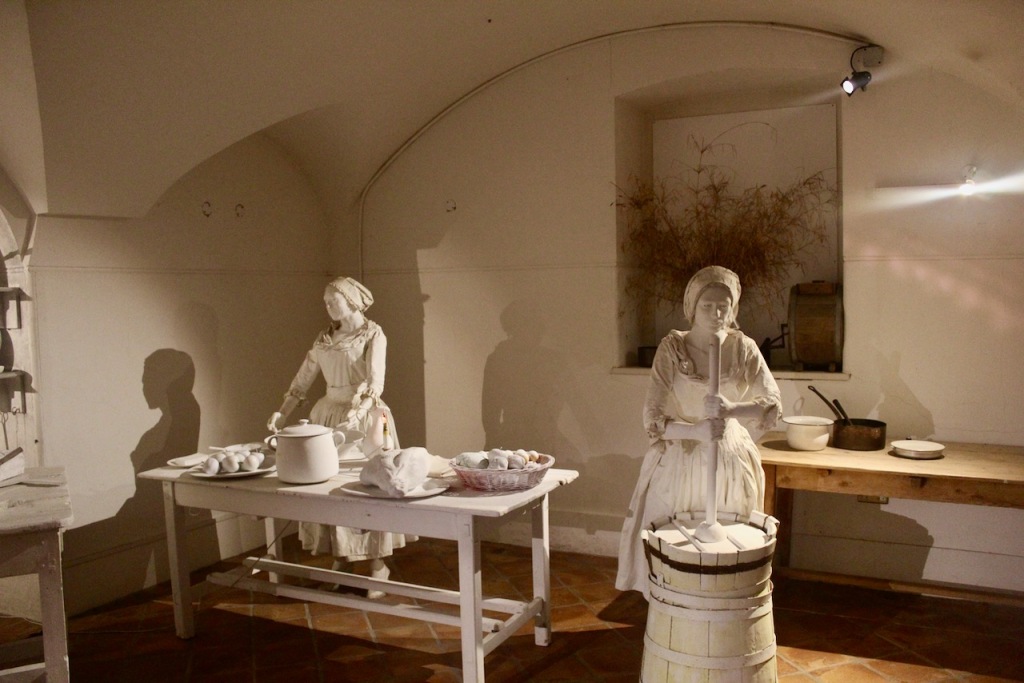




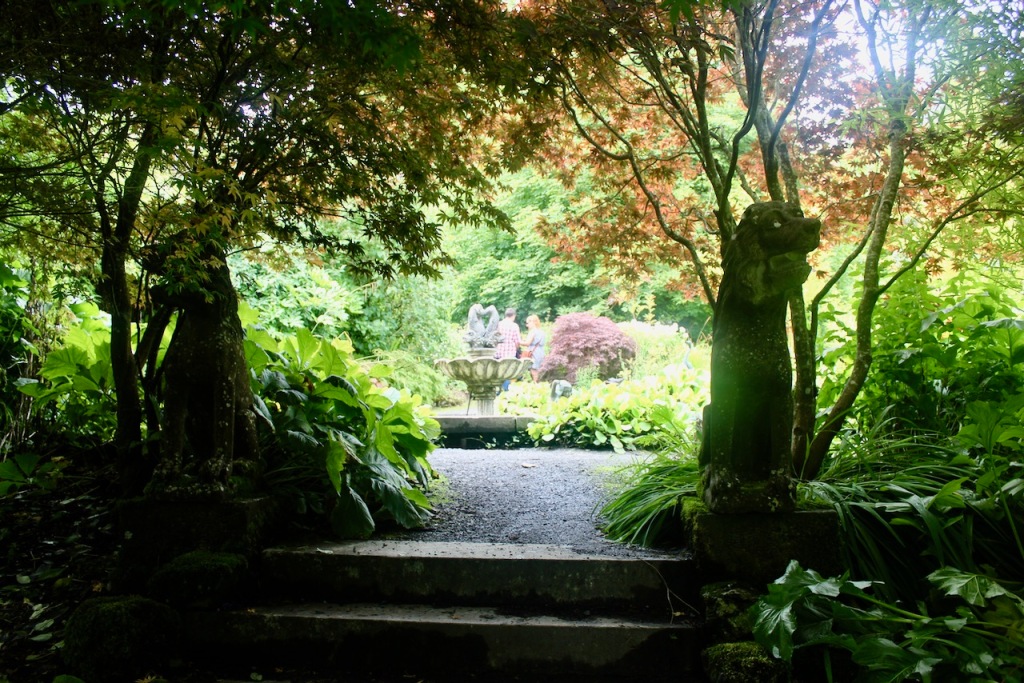


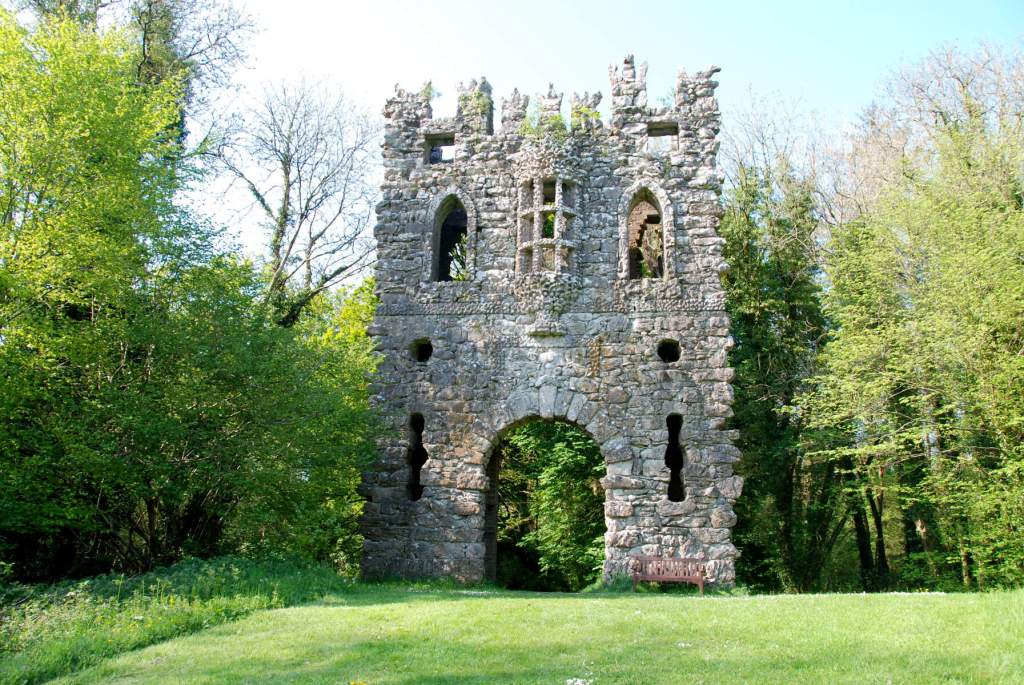


3. Killua Castle, County Westmeath
https://killuacastle.com/guided-tours/
4. Lough Park House, Castlepollard, Co. Westmeath
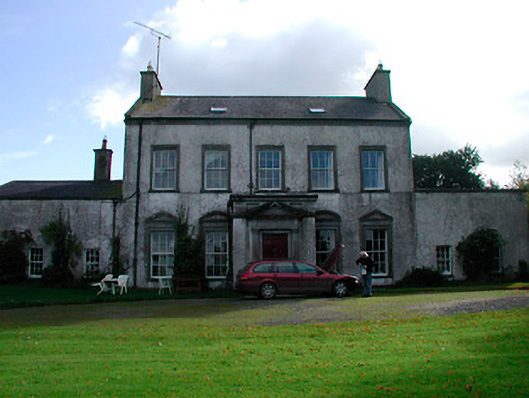
Open dates in 2024: Mar 15-21, 28-31, Apr 1-3, May 1-7, June 1-9, July 12-25, Aug 1-7, 17-25, 2pm-6pm
Fee: adult €6
5. Rockfield Ecological Estate, Rathaspic, Rathowen, Mullingar, Co. Westmeath
Open dates in 2024: May 20-30, June 19-30, July 19-30, Aug 15-25, Sept 11-30, 2pm-6pm
Fee: Free
6. St. John’s Church, Loughstown, Drumcree, Collinstown, Co. Westmeath

Open dates in 2024: July 1-31, Aug 1-30, 2pm-6pm
Fee: free
7. Tullynally Castle & Gardens, Castlepollard, Co. Westmeath N91 HV58
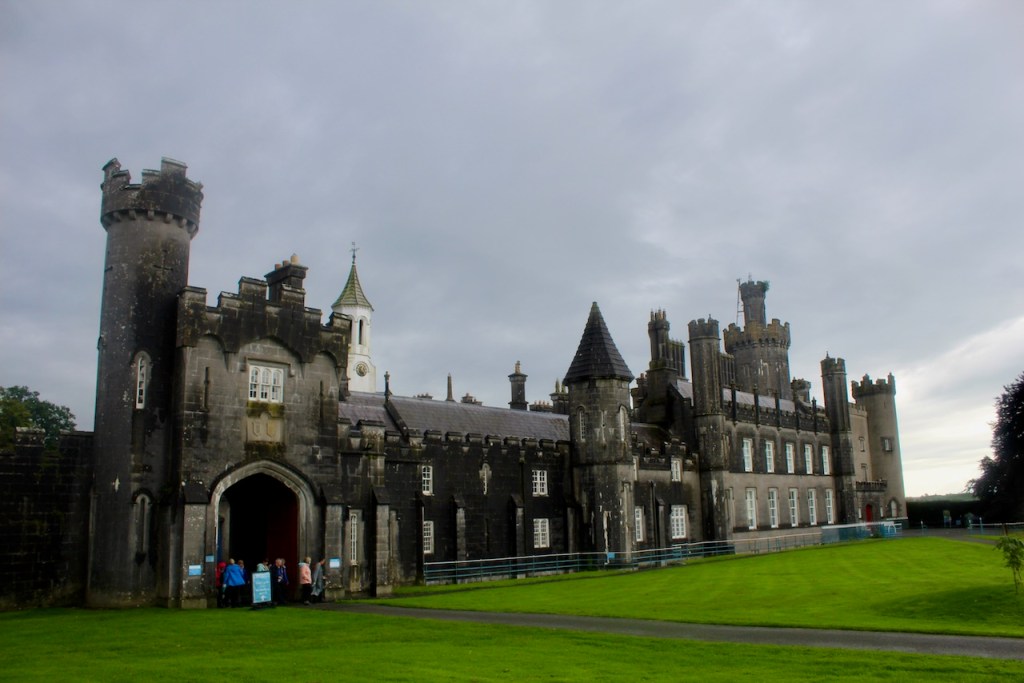
www.tullynallycastle.com
Open dates in 2024:
Castle, May 2-31, June 1-29, July 4-20, Aug 1-31, Sept 5-21, Thurs- Sat, National Heritage Week, Aug 17-25, 11am-3pm
Garden, May 2-Sept 29, Thurs-Sundays, and Bank Holidays, National Heritage Week, Aug 17-25, 11am-5pm
Fee: castle/garden adult €16.50, child over 10 years €8.50, OAP/student free, garden, adult €8.50, child €4, family ticket (2 adults + 2 children) €23, adult season ticket €56, family season ticket €70, special needs visitor with support carer €4
8. Turbotstown, Coole, Co. Westmeath
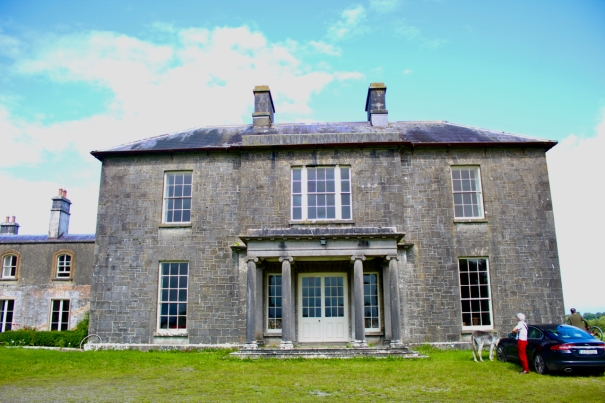
Open dates in 2024: Aug 1-31, Sept 1-9, Dec 1-20, 9am-1pm
Fee: adult/student/OAP €8, child €4
We visited in 2023, https://irishhistorichouses.com/2023/11/23/turbotstown-coole-co-westmeath/
and see Robert O’Byrne’s entry about Turbotstown, https://theirishaesthete.com/2015/10/19/a-fitting-tribute-to-the-past/
9. Tyrrelspass Castle, Co Westmeath – restaurant and gift shop
https://www.facebook.com/tyrrellspasscastle/
Places to stay, County Westmeath:
1. Annebrook House Hotel, Austin Friars Street, Mullingar, Co.Westmeath, Ireland, N91YH2F. €
https://www.annebrook.ie/gallery.html
“The family run Annebrook House Hotel Mullingar opened its doors February 2007. Originally an Old Georgian residence for the local county surgeon, Dr O’Connell, the historic Annebrook House Hotel was purchased by the Dunne family in 2005. With his experience in hospitality and construction Berty Dunne set about creating a hotel as unique as the man who owns it. The Annebrook’s central location, its diverse range of accommodation from 2 bedroomed family suites to executive doubles has made it a very popular location for those coming to experience all that the midlands has to offer.
“Situated in the heart of Mullingar overlooking 10 acres of parkland, the Award Winning 4 star Annebrook House Hotel presents a modern day styling coupled with 17th century heritage. As a family run hotel the Annebrook prides itself on quality and high standards of customer service, working as part of one team to ensure all guests of their best and personal attention at all times. Annebrook House Hotel is steeped in history and enjoys the enviable advantage of being one of the most centrally located hotels in Mullingar town. This unique venue mixes old world charm with modern comfort and has established itself as one of Westmeath’s top wedding venues and was recently voted Best Wedding Venue Ireland by Irish Wedding Diary Magazine. With accommodation ranging from executive hotel rooms, family suites, luxurious champagne suites and apartments, the Annebrook has much to offer those visiting Mullingar. Offering a range of dining options from Berty’s Bar to fine dining in the award winning Old House Restaurant. The four star Annebrook House Hotel offers an excellent service to both its corporate & leisure guests. The hotel is accessible by car just 50 mins from Dublin and is only 10 minutes from the local Train Station.“
2. Lough Bawn House, Colllinstown, Co Westmeath – B&B accommodation €€
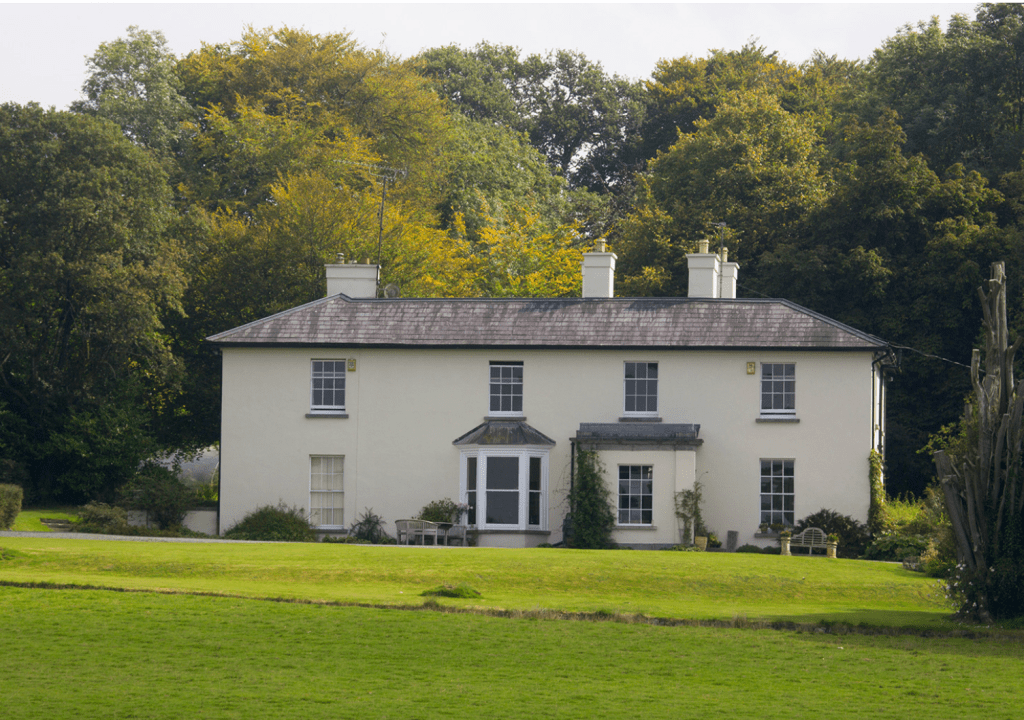
“A classic Georgian house in a unique setting. Lough Bawn house sits high above Lough Bane with amazing sweeping views. Nestled in a 50 acre parkland at the end of a long drive, Lough Bawn House is a haven of peace and tranquillity.
“The house and estate has been in the same family since it was built in 1820 by George Battesby, the current occupier, Verity’s, Great Great Great Grandfather. The house is being lovingly restored by Verity, having returned from England to live in the family home. Verity ran her own catering and events company in Gloucestershire for over 20 years. Her passion for cooking & entertaining shines through. Guests enjoy an extensive and varied breakfast with much of the ingredients being grown or reared by Verity herself, and delicious dinners are on offer. Breakfast is eaten in the large newly restored dining room, with wonderful views over the lough and of the parading peacocks on the rolling lawns.“
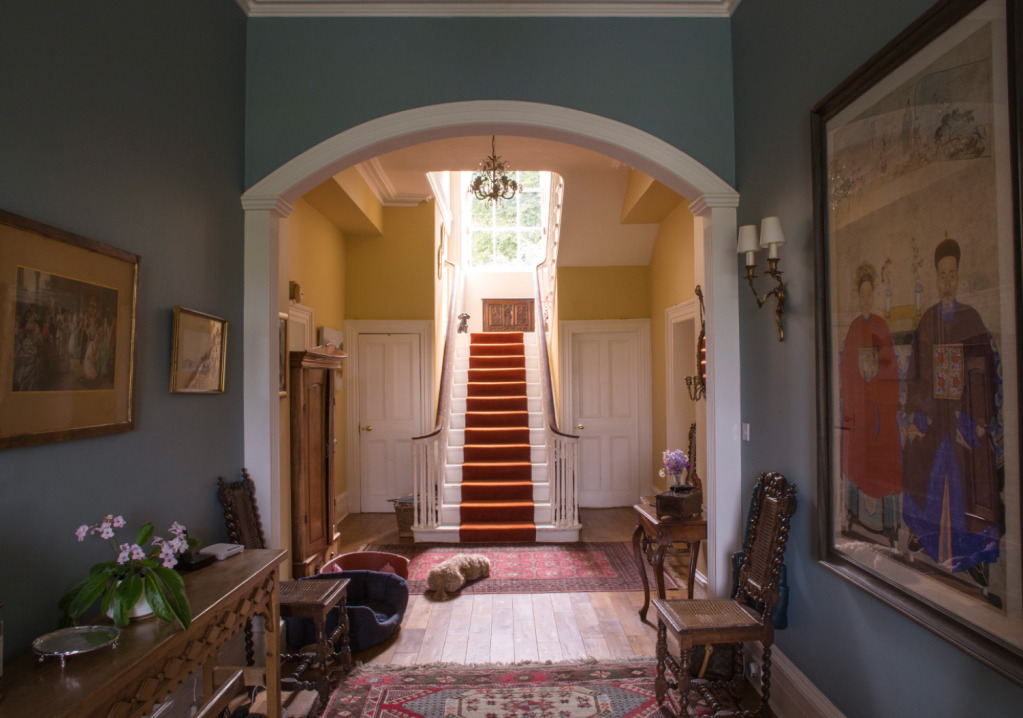

“Both of the large, en-suite rooms have fine views down the length of Lough Bane and over the wooded hills while the single room and the twin/double room have sweeping views of the surrounding parklands. Guests are warmly welcomed and encouraged to relax in the homely drawing room in front of a roaring fire or to explore one of the many local historical sites, gardens, walks or cultural entertainments on offer.
Several areas of the estate have been classified as Special Areas of Conservation (SAC‘s) due to the incredibly varied and rare flora. Wild flowers can be found in abundance and a charming fern walk has been the created amongst the woodland near the house.“
3. Lough Bishop House, Collinstown, County Westmeath €
The website tells us:
“Built in the early 19th Century, Lough Bishop is a charming Country House nestling peacefully into a south-facing slope overlooking Bishop’s Lough in County Westmeath, Ireland.
“Breathtaking scenery in an unspoilt and tranquil setting, amid the rolling farmlands and lakes of Westmeath make Lough Bishop an ideal refuge from the hustle and bustle of modern life. There are family dogs in the background and animals play a large part of life at Lough Bishop House.
“Lough Bishop House is a family run business offering Country House Bed & Breakfast accommodation in a wonderful location in the middle of a working organic farm. We even have a purpose built trailer towed behind the quad bike to give guests a tour of the farm and the opportunity to get up close to the animals.
“Following extensive renovation this attractive Georgian Country Farmhouse offers its guests luxurious bed and breakfast accommodations, peaceful surroundings and fine home cooked food much of which comes from our own farm, garden and orchard.“
4. Mornington House, County Westmeath – B&B accommodation

“Mornington House, a historic Irish Country Manor offering luxury country house accommodation located in the heart of the Co. Westmeath countryside, just 60 miles from Ireland’s capital city of Dublin. Tranquility and warm hospitality are the essence of Mornington, home to the O’Hara’s since 1858.
“Mornington House is hidden away in the midst of a charming and dramatic landscape with rolling hills, green pasture, forests with ancient, heavy timber and sparkling lakes, deep in an unexplored corner of County Westmeath. Nearby are ancient churches, castles and abbeys, and delightful small villages to explore, away from all hustle and bustle of 21st century life, yet just 60 miles from Dublin.
“There has been a house at Mornington since the early 17th century but this was considerably enlarged in 1896 by Warwick’s grandparents. It is now a gracious family home with a reputation for delicious breakfasts which are prepared in the fine tradition of the Irish Country House and really set you up for the day ahead.
“A special place to stay for a romantic or relaxing break Mornington House’s location in the centre of Ireland just an hour’s drive from Dublin and Dublin Airport makes it ideal for either a midweek or weekend country break. Guests can walk to the lake or wander round the grounds. Excellent golf, fishing, walking and riding can be arranged. The Hill of Uisneach, the Neolithic passage tombs at Loughcrew and Newgrange and the early Christian sites at Fore and Clonmacnoise are all within easy reach, as are the gardens at Belvedere, Tullynally and Loughcrew.“
The National Inventory tells us:
“A well-detailed middle-sized country house, on complex plan, which retains its early aspect, form and much of its important early fabric. The ascending breakfronts to the entrance front of this structure adds to the overall form and its architectural impact. The facade, incorporating extensive moulded detailing and a very fine doorcase, is both visually and architecturally impressive and displays a high level of workmanship. The present entrance front (east) is built to the front of an earlier house, the form of which suggests that it might be quite early, perhaps early eighteenth-century in date. The 1896 entrance front was built to designs by W.H. Byrne (1844-1917), a noted architect of his day, best remembered for his numerous church designs. Apparently, Mornington is one of only two domestic commissions that can be attributed to this noteworthy architect, adding extra significance to this structure. The building was completed by 1898 at a cost of £2,400. Mornington House was in the ownership of the Daly Family in the early eighteenth-century and has been in the ownership of the O’Hara Family since 1858. It forms the centrepiece of an interesting, multi-period, complex with the outbuildings, the walled gardens and the fine entrance gates to the south. It represents an important element to the architectural heritage of Westmeath and occupies attractive nature grounds to the east of Multyfarnham.” [9]
Whole House accommodation, County Westmeath:
1. Bishopstown House, Rosemount, Westmeath (sleeps up to 18 people)
https://www.bishopstownhouse.ie

The website tells us of the history:
“Bishopstown House is a three-storey Georgian house built in the early 1800s by the Casey family. After he passed away, the original owner, Mr. J Casey left Bishopstown to his two daughters, who then sold the house to Mr Richard Cleary in 1895.
“Mr Richard Cleary, formally from the famed lakeside Cleaboy Stud near Mullingar, planned and erected Bishopstown House and Stud. In his younger days he rode horses at Kilbeggan, Ballinarobe, Claremorris and other Irish meetings with varying degrees of success, but as a trainer he knew no bounds. In his later years he devoted his time to breeding and training, and in time he became one of Ireland’s most famous trainers, breeding some excellent horses, including the winner of the 1916 Irish Grand National, Mr James Kiernan’s All Sorts!
“Other famous horses from the Bishopstown stud include Shaun Spada and Serent Murphy who both won the Aintree Grand National in England. Another horse called Dunadry won the Lancashire Steeple Chase. Other stallion winners include Sylvio III, Lustrea and Irish Battle who frequently had their names in the limelight throughout Irish and English racecourses.
“After being left fall into a dilapidated state, the stud farm and house was purchased by Paddy and Claire Dunning, the owners of the award-winning Grouse Lodge Recording Studios and Coolatore House and members of the Georgian society. It was restored to its former glory in 2009 and is now available for rent.“
2. Middleton Park, Mullingar, County Westmeath – wedding venue and accommodation
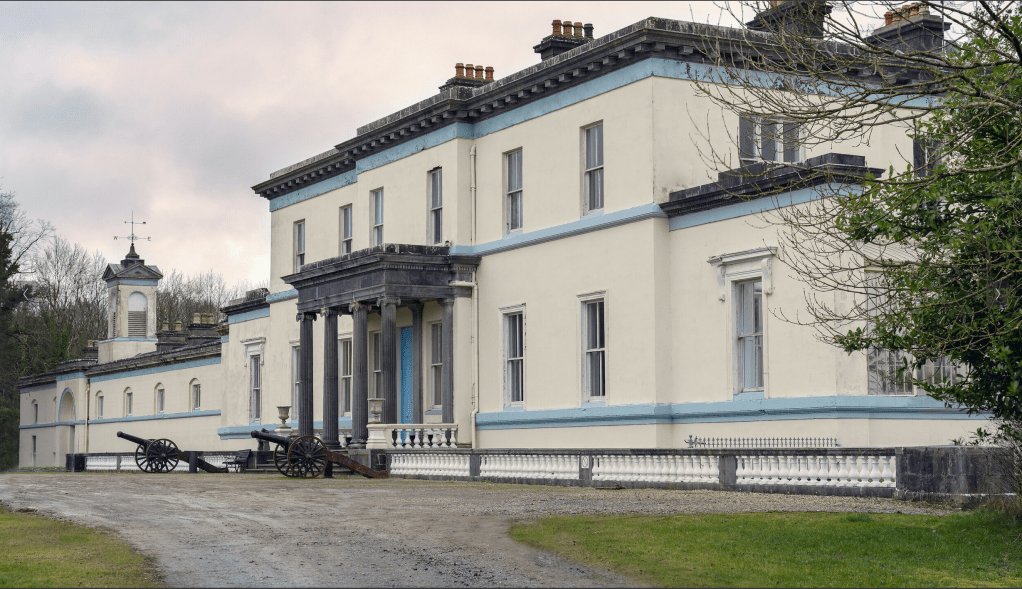
https://www.middletonparkhouse.com
Middleton Park House featured in The Great House Revival on RTE, with presenter (and architect) Hugh Wallace. The website tells us:
“Carolyn and Michael McDonnell, together with Carolyn’s brother Henry, joined together to purchase this expansive property in Castletown Geoghegan. Built during the famine, the property was last in use as a hotel but it had deteriorated at a surprisingly fast rate over its three unoccupied years.
“Designed by renowned architect George Papworth, featuring a Turner-designed conservatory, Middleton Park House stands at a palatial 35,000sq. ft. and is steeped in history. Its sheer scale makes it an ambitious restoration.
“The trio’s aim is to create a family home, first and foremost, which can host Henry’s children at the weekends and extended family all year-round. Due to its recent commercial use, the three will need to figure out how to change industrial-style aspects to make it a welcoming home that is economical to run.
“Henry will be putting his skills as a contractor and a qualified chippy to use, and Michael will be wearing his qualified engineer’s hat to figure out an effective heating system. Carolyn will be using her love of interiors to work out the aesthetic of the house, and how to furnish a property the size of 35 semi-detached houses in Dublin.“

The trio have now made the house available for accommodation and as a wedding venue.
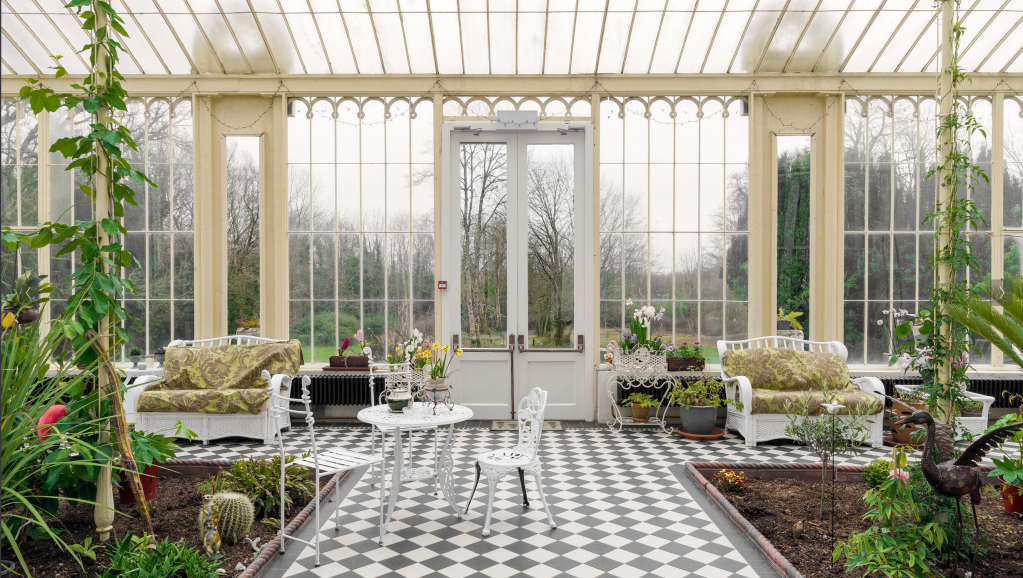
The National Inventory tells us:
“A very fine and distinguished large-scale mid-nineteenth country house, which retains its early form, character and fabric This well-proportioned house is built in an Italianate style and is elevated by the fine ashlar limestone detailing, including a well-executed Greek Ionic porch/portico and a pronounced eaves cornice. This house was (re)built for George Augustus Boyd [1817-1887] in 1850 to designs by George Papworth (1781-1855) and replaced an earlier smaller-scale house on site, the property of a J. Middleton Berry, Esq., in 1837 (Lewis). The style of this house is quite old fashioned for its construction date and has the appearance of an early-nineteenth/late-Georgian country house. The form of this elegant house is very similar to Francis Johnston’s masterpiece Ballynagall (15401212), located to the north of Mullingar and now sadly in ruins. This house remained in the Boyd-Rochfort family until 1958 and was famously offered as a prize in a raffle in 1986 by its then owner, Barney Curly. This house forms the centerpiece of an important collection of related structures along with the elegant conservatory by Richard Turner (15318024), the service wing to the north (15318020), the stable block to the north (15318022) and the main gates (15318017) and the gate lodge (15318018) to the west. This building is an important element of the built heritage of Westmeath and adds historic and architectural incident to the landscape to the south of Castletown Geoghegan.” [10]
[2] https://www.irelandscontentpool.com/en
[3] Bence-Jones, Mark. A Guide to Irish Country Houses (originally published as Burke’s Guide to Country Houses volume 1 Ireland by Burke’s Peerage Ltd. 1978); Revised edition 1988 Constable and Company Ltd, London.
[4] p. 136. O’Reilly, Sean. Irish Houses and Gardens. From the Archives of Country Life. Aurum Press Ltd, London, 1998.
[6] https://www.ihh.ie/index.cfm/houses/house/name/Gloster%20House